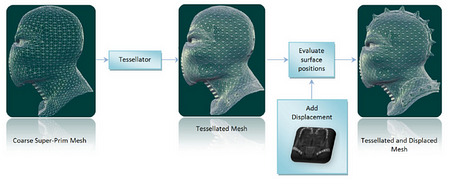Next-Gen 3D Rendering Technology: Voxel Ray Casting
The Advantages Of Sparse Voxel Octrees (Continued)
A number of researchers have worked on ways to make the move from one level of detail to another smoother, using what’s called a progressive mesh. The idea is, for each level of detail, to separate the vertices into two groups: parent vertices and child vertices. When the level of details decreases, the child vertices gradually draw closer to their parents. When the level of detail reaches a new integer value, the child vertices are deleted, along with all of the edges that connected them to their parents.
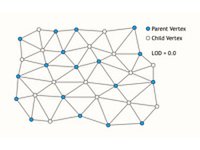
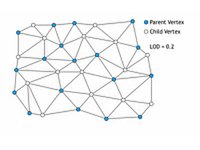
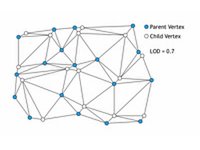
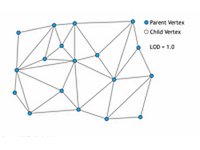
This technique works, but it’s not completely automatic. It requires additional input from the artists to indicate which edges are most important to preserve. That additional work means less time available for refining models.
Another way of solving the problem (which we’re hearing a lot about with the arrival of DirectX 11 cards ) is tessellation of higher-order primitives (patches), possibly coupled with displacement mapping. The arrival of this technique has appeared promising on paper for years (ah, the Parhelia…) without any real concrete results. But maybe this time it’ll be for real.
Once again, the technique is valid and could well meet with a certain level of success, given the efforts of Microsoft and AMD to push developers in that direction. But voxel octrees remain a tempting alternative. As we said above, they can solve the problem of geometry and texture with a single algorithm, and in addition, the selection of level of detail is very easy. After all, evaluating the size of a voxel on the screen is simple, but it’s more complicated for a triangle.
Get Tom's Hardware's best news and in-depth reviews, straight to your inbox.
Current page: The Advantages Of Sparse Voxel Octrees (Continued)
Prev Page The Advantages Of Sparse Voxel Octrees Next Page Potential Limitations Of Voxels-
doomtomb This stuff is pretty interesting but a little over my head. The only thing I really care about is when we will start seeing this in our games.Reply -
the_krasno This is awesome, the people that can really gain something here are amateur filmmakers that can't afford the giant rendering farms big studios have! :)Reply -
the_krasno the_krasnoThis is awesome, the people that can really gain something here are amateur filmmakers that can't afford the giant rendering farms big studios have!I meant independent, not amateur. Sorry.Reply -
personally i like raytracing, except for the performance issues. if you've ever tried doing a little 3d rendering, ray tracing is very good, makes things look very real if done properly. again i know it is slowReply
-
liquidsnake718 Very interesting stuff, I do understand how limiting cubes or voxels can be limited in terms of depth and height(same height per distance) as polygons have that advantage where the triangle gives us just that, an angle that can be measured in terms of height and distanve. We have a vanishing point with a triangle as well.....Reply
Iwonder if they can impliment both polygons and advanced cubes with different sizes for the initial layers creating a more fluid and complexed scenario or landscape........ -
JonathanDeane Interesting but voxels will have some extreme performance and space constraint hurdles to overcome before they become the main rendering of any game. I just downloaded a small demo http://www.advsys.net/ken/voxlap/voxlap03.htm its a little over 500K for the whole works but after you hit the genall batch file (it speeds up loading) the thing occupies about 120MB's of space for this simple game. Something like Quake 3 would have been a multi DVD file...Reply
